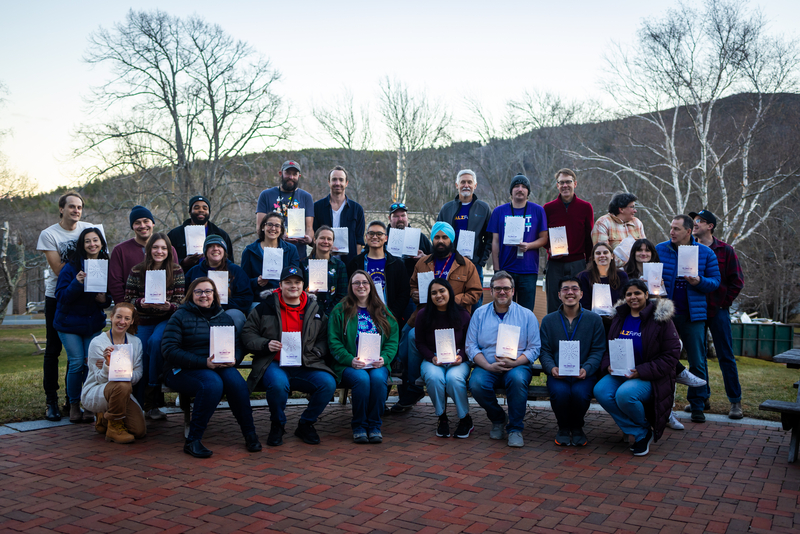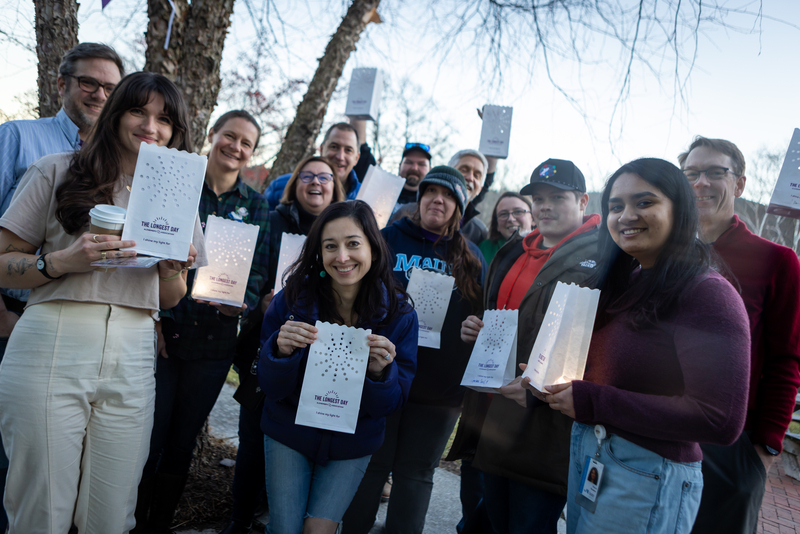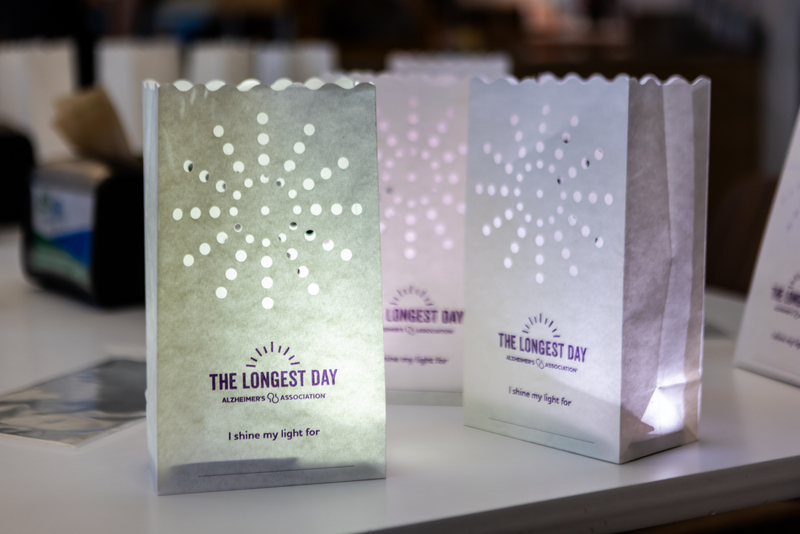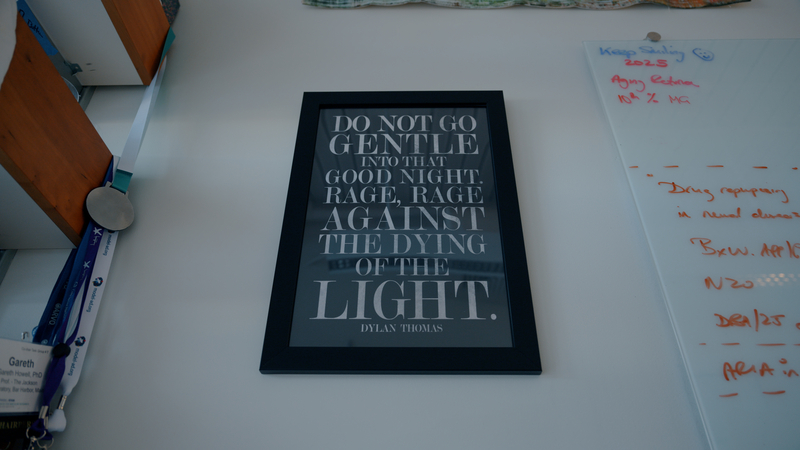
The two organizations have partnered for over a decade to bring education, resources and cutting-edge research to Maine patients and families.
Gareth Howell believes that his Bar-Harbor based lab has a unique distinction – seeing the sun rise first on The Longest Day, an annual recognition and fundraising event for Alzheimer’s disease held on June 21, the summer solstice. The
Jackson Laboratory’s location on Mount Desert Island, in one of the most northeastern spots in the country, has its advantages – and this is one of them.It’s a meaningful designation because The Longest Day is incredibly important to the Howell lab, which studies Alzheimer’s disease, the genetic and environmental risk factors of eye diseases, and related neurodegenerative conditions. Not only do they put in countless research hours trying to find solutions for these – so far – incurable conditions, but the lab makes a concerted effort to connect the science to the individuals and families affected by it.
Case in point: their 10-year-plus relationship with the Maine Chapter of the Alzheimer’s Association, an organization that provides support services, care options and education for Maine families and caregivers affected by this disease. The two organizations have worked together on countless projects, initiatives and events to raise awareness for Alzheimer’s, as well as to ensure Maine residents are equipped with the most up-to-date, research-backed advice for prevention and treatment.
In December, they jointly kicked off the countdown to The Longest Day on the shortest day of the year, referred to as The Longest Night. Organized by the Howell lab’s Amanda Hewes and Rita O’Rourke, members of the JAX Center for Alzheimer’s and Dementia Research participated in the Alzheimer’s Association’s virtual luminary lighting, which symbolizes hope for a brighter future in treating this condition. On the longest, darkest night of the year, the event both metaphorically and literally illuminates the path toward hope for treating this condition through the collective effort of researchers, advocates and families around the world.
“Hope” is a common theme in the Alzheimer’s world. Affecting nearly 7 million Americans, Alzheimer’s is a progressive neurodegenerative disorder that affects memory, thinking and behavior, and while there are some treatments available, there is currently no cure. In Maine, the state with the nation’s highest median age, nearly 30,000 people are living with Alzheimer’s.
In the Howell lab, researchers are working to identify the fundamental processes involved in Alzheimer’s and related conditions. They strive to contribute resources or research discoveries for the development of therapeutic interventions that will make a real difference to those suffering from this devastating disease because, although there have been some promising discoveries over the years, the effectiveness of available drugs for Alzheimer’s is still limited. Combining knowledge from human genetic studies with the wide array of mouse strains available at JAX, the Howell lab works with other labs at JAX, including the labs of Greg Carter and Mike Sasner, to develop new and improved models for dementias and make them available to the scientific community. This collaborative approach, that involves institutes across the USA such as Indiana University and University of Pittsburg, allows everyone to benefit from these resources and work more efficiently toward solutions.

The Howell lab and fellow JAX researchers take the same collaborative approach in the Maine community. Working with the Alzheimer’s Association, the lab delivers the proven science that buoys the Association’s mission, and, in turn, the lab gains visibility for their research efforts through the Association’s well-attended conferences, workshops and other advocacy events.
“We love working with this group,” said Howell of the relationship. “We can bring the impact back to Maine. Maine is small, it’s rural, it’s often underfunded. We want to make sure this state gets access to the latest advancements as early as anyone else.”
Their joint philosophy is simple: the more individuals they can reach with research findings, educational materials, and access to clinical trials and emerging treatments, the better off everyone in the state will be.
“Working with the people who have this disease really gives meaning to that research,” said Drew Wyman, executive director of the Maine Chapter, who noted that funding cutting-edge Alzheimer’s studies is one of the group’s top priorities. “When you look at what’s going on in Maine, we’ve got it all – collaboration, research and advocacy; it’s happening in our own backyard.”
On Jan. 22, researchers from Howell’s and Kristen O’Connell’s labs, along with the JAX External and Government Affairs team, visited the State Capitol building in Augusta for an annual advocacy day organized by the Alzheimer’s Association. JAX has been attending the event on and off for over ten years, in hopes of inspiring important legislation and funding for Alzheimer’s.
Those advocacy efforts pay off. Together, JAX and the Maine Chapter of the Alzheimer’s Association collaborated to launch state plans and initiatives that fuse the latest research with tangible health recommendations, serving as a model for other states.

These efforts include serving on the task force that produced the Maine State Plan for Alzheimer’s Disease – a thorough guide to help the state meet the needs of individuals impacted by the disease – as well as the Healthy Brain Initiative Road Map, a framework to help public health professionals take a lead in their communities to improve brain health and support caregivers. The initiative identifies the best practice recommendations for preventing Alzheimer’s disease, from good sleep to a healthy diet to everything in between.
“We’ve done research at JAX on the positive implications of exercise and healthy diet in relation to preventing Alzheimer’s and we want promote healthy living through the Healthy Brain Initiative,” said Howell. “Therapeutics are, of course, crucial, but it’s always better to prevent something if you can.”
Together, JAX and the Alzheimer’s Association are actively moving towards a brighter future. Howell believes that new findings in realms like blood-based and other biomarkers could prove invaluable in early detection of Alzheimer’s, which is traditionally very difficult to diagnose. His lab just published a new paper in the journal Molecular Degeneration setting the stage to understand how the eye may be an invaluable biomarker, meaning that someday a simple visit to your optometrist or ophthalmologist could include this sort of testing. The research helps explain how genetics play a role in retinal aging, which could pave the way for treatments for age-related diseases in both the eye and brain.
The science, the advocacy and education efforts, the relentless planning: it is all evidence of a powerful relationship rooted in a true desire to make things better – based on the real people living through the Alzheimer’s experience.
“Having access to blood-based biomarkers for diagnosis would enable medical professionals to accurately diagnose. We advocate for early and accurate diagnosis as the current treatments available are for those in the very early stages,” says Wyman. “We encourage folks to talk to their doctors about risk reduction and early diagnosis.”

Howell and Wyman both fondly recall a powerful event several years back when a member of the Alzheimer’s Early-Stage Advisory Group shared his personal experience living with Alzheimer’s and read the Dylan Thomas poem, “Do Not Go Gently into That Good Night,” at an advocacy roundtable in Bangor.
Howell immediately ordered a framed verse of the poem for his office, where it still hangs. It’s another reminder of the hope – and light – these two organizations keep at the forefront of their minds and their ongoing efforts. It begins:
“Do not go gentle into that good night,
Old age should burn and rave at close of day;
Rage, rage against the dying of the light.”
“Now more than ever, it is vital we establish strong partnerships across Maine,” Howell says. “The people and the environment in Maine foster collaborations and friendships, and it’s through these connections that we will improve health outcomes for all Mainers.”

No comments:
Post a Comment